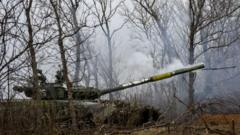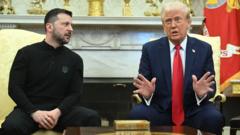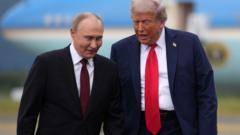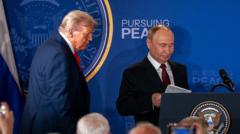While tensions remain high, this bold move may pave the way for lasting peace in a region fraught with danger.
**Trump's Gamble: Iran-Israel Ceasefire Offers Hope for Stability**

**Trump's Gamble: Iran-Israel Ceasefire Offers Hope for Stability**
In a dramatic turn of events, President Trump's involvement in the Iran-Israel conflict has led to a potential ceasefire.
The White House has announced a potential ceasefire agreement between Iran and Israel, a significant step back from escalating conflict. President Donald Trump, who took a notable risk by escalating U.S. involvement, remarked on Tuesday evening that these developments could mark the end of what he defined as the "12 Day War." This ceasefire, conditioned on Israel ceasing its military operations by a strict deadline, represents a notable de-escalation of a situation that threatened to spiral dangerously out of control, particularly after recent U.S. airstrikes on Iranian nuclear sites.
Iran’s Foreign Minister, Abbas Araghchi, stated that Iran’s responses would halt if Israel adhered to this truce, hinting at an opening for dialogue. As the deadline approached, Israeli operations reportedly ceased, indicating a potential thaw in hostilities. The day was marked by further tensions, however, as Iran retaliated against American forces based in Qatar, striking with missiles that were successfully intercepted, resulting in no American casualties.
President Trump’s rhetoric continued to focus on the need for overwhelming U.S. military response to any Iranian threats, while further emphasizing that Iran’s counteraction had not met his expectations. Amid fears of escalation, Trump expressed hope for a peaceful resolution, insisting that the recent Iranian strikes were a weaker response than anticipated.
As the situation develops, Trump's administration is reportedly engaged in ongoing discussions with Qatari mediators and Israeli leaders to manage the ceasefire talks. Historical context reveals that similar scenarios have played out, demonstrating how measured responses can lead to decreased tensions, as witnessed after the U.S. killed Qasem Soleimani in early 2020, resulting in restrained retaliations from Iran.
The unfolding negotiation efforts signal a desire on both sides to reduce hostilities and potentially avert more significant conflict, with Trump aiming to find a diplomatic off-ramp amidst the tumult. While uncertainty lingers, the current trajectories offer glimmers of hope for a region long plagued by strife, positioning the ceasefire as a pivotal moment in the fraught history of U.S.-Iran relations.
Iran’s Foreign Minister, Abbas Araghchi, stated that Iran’s responses would halt if Israel adhered to this truce, hinting at an opening for dialogue. As the deadline approached, Israeli operations reportedly ceased, indicating a potential thaw in hostilities. The day was marked by further tensions, however, as Iran retaliated against American forces based in Qatar, striking with missiles that were successfully intercepted, resulting in no American casualties.
President Trump’s rhetoric continued to focus on the need for overwhelming U.S. military response to any Iranian threats, while further emphasizing that Iran’s counteraction had not met his expectations. Amid fears of escalation, Trump expressed hope for a peaceful resolution, insisting that the recent Iranian strikes were a weaker response than anticipated.
As the situation develops, Trump's administration is reportedly engaged in ongoing discussions with Qatari mediators and Israeli leaders to manage the ceasefire talks. Historical context reveals that similar scenarios have played out, demonstrating how measured responses can lead to decreased tensions, as witnessed after the U.S. killed Qasem Soleimani in early 2020, resulting in restrained retaliations from Iran.
The unfolding negotiation efforts signal a desire on both sides to reduce hostilities and potentially avert more significant conflict, with Trump aiming to find a diplomatic off-ramp amidst the tumult. While uncertainty lingers, the current trajectories offer glimmers of hope for a region long plagued by strife, positioning the ceasefire as a pivotal moment in the fraught history of U.S.-Iran relations.





















